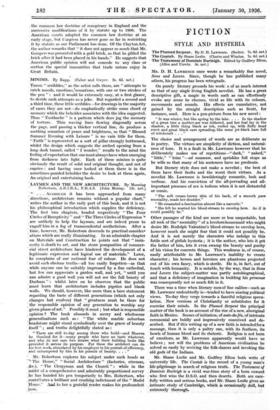• LAYMEN AND THE NEW ARCHITECTURE. By Manning Robertson, A.R.I.B.A.,
F.R.A.S. (John Murray. 12s. net.) • " . . . ALTHOUGH it has been approached from many c directions, architecture remains without a popular chart,"
writes the author in the early part of this book, and it is not his philosophical introduction which supplies the deficiency. The first two chapters, headed respectively "The Four Circles of Receptivity" and" The Three Circles of Expression" are unlikely to help the layman, and are indeed prone to ' engulf him in a fog of transcendental aestheticism. After a time, however, Mr. Robertson descends to practical consider- ations which are really illuminating. In an admirable chapter Ton Materials and Construction he points out that " insin- . cerity is death to art, and the stone pomposities of commer- cial street architecture have hindered the development of a legitimate expression and logical use of materials." Later, he complains of our national fear of colour. He does not ' avoid such obvious truths—all too easily forgotten—as that while anyone can be suitably impressed by a fine cathedral, but few can appreciate a garden wall, and yet, "until you can admire a good wall you will not see the full beauty of Durham " : whilst later on he observes that the public ; must learn that architecture includes pigsties and blank walls. We should, however, like more than a bare statement regarding the taste of different generations (which not only changes but evolves) that "greatness must be there for the responsible opinion of any generation to worship any given phase of art." Possibly it must ; but what is responsible .
opinion ? The book abounds in merry and wholesome generalizations such as : "The white marble suburban headstone might stand symbolically over the grave of beauty itself " ; and truths delightfully stated as :
"There are still to-day among those who build—and Heaven be thanked for it--many people who have no taste whatever, and who do not care two straws what their building looks like provided it serves its purpose. For these the architect can do • his best work, stimulated by his employer in his pursuit of efficiency, and unhampered by him in his pursuit of beauty. . . . "
' Mr. Robertson explores his subject under such heads as The House," "Social Architecture" (factories, cinemas,
• contributes a brilliant and crushiiig indictment of the "Model
&c.), The Clergyman and the Church " : while in the -midst of a comprehensive and admirably proportioned survey he has handed his pen temporarily to Mrs. Robertson, who - Home." And to her a grateful reader makes his profoundest .•• bow. . • extremely thorough.


















































 Previous page
Previous page